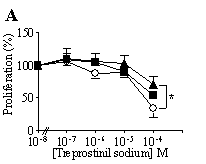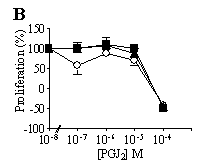| pA2 online © Copyright 2004 The British Pharmacological Society |
004P
GKT, University of London Winter Meeting December 2003 |
|
The prostacyclin
mimetic treprostinil sodium inhibits lung cell proliferation: role
of PPAR |
|
Prostaglandin (PG)
I2 and mimetics, e.g. treprostinil sodium,
are used for the treatment of pulmonary hypertension because of their
ability to reduce the accelerated proliferation of pulmonary vascular
cells and fibroblasts. PGI2 is known
to act via activation of cell surface IP receptors. However, PGI2
and some of its mimetics are also ligands for peroxisome proliferator-activated
receptor delta (PPAR![]() )
(Lim and Dey, 2002). There are currently few pharmacological tools available
to study specifically IP or PPAR
)
(Lim and Dey, 2002). There are currently few pharmacological tools available
to study specifically IP or PPAR![]() receptor function. Here, therefore, we have compared the responses to
treprostinil sodium (donated by United Therapeutics Corp) and other mimetics
of lung fibroblasts cultured from wild-type mice, PPAR
receptor function. Here, therefore, we have compared the responses to
treprostinil sodium (donated by United Therapeutics Corp) and other mimetics
of lung fibroblasts cultured from wild-type mice, PPAR![]() -deficient
mice, and IP-deficient mice.
-deficient
mice, and IP-deficient mice.
Lungs from PPAR![]() -/-,
IP-/- or wild-type control (BLK6) mice
were cultured into supplemented DMEM using standard explant protocols
(Stanford et al., 2003). Explanted cells were detached and re-seeded at
40% confluence in 96-well plates. 24 h later the medium was replaced with
fresh DMEM containing BSA (0.1%) but no FCS. Cells were then rested for
2 h before the addition of test drugs or vehicle controls. 4 h later proliferation
was stimulated by the addition of FCS (3 %) and cells were then incubated
(5% CO2 in air; 37 °C) for a further
72 h. Proliferation was quantified using a fluorescence assay (CYQUANT;
Cambridge Bioscience).
-/-,
IP-/- or wild-type control (BLK6) mice
were cultured into supplemented DMEM using standard explant protocols
(Stanford et al., 2003). Explanted cells were detached and re-seeded at
40% confluence in 96-well plates. 24 h later the medium was replaced with
fresh DMEM containing BSA (0.1%) but no FCS. Cells were then rested for
2 h before the addition of test drugs or vehicle controls. 4 h later proliferation
was stimulated by the addition of FCS (3 %) and cells were then incubated
(5% CO2 in air; 37 °C) for a further
72 h. Proliferation was quantified using a fluorescence assay (CYQUANT;
Cambridge Bioscience).


Effects
of (A) treprostinil sodium and (B) 15 deoxy-![]() 12,14-PGJ2
on proliferation of lung fibroblasts from wild-type (WT; open circles),
PPARd
12,14-PGJ2
on proliferation of lung fibroblasts from wild-type (WT; open circles),
PPARd![]() /-
(filled triangles) or IP-/- (filled
squares). Proliferation was calculated as % growth induced by FCS. Data
is mean ± s.e.m for n=6 determinations using cells cultured from
2 separate animals for data point, except graph B WT where n=12 (p<0.05;
two-way ANOVA).
/-
(filled triangles) or IP-/- (filled
squares). Proliferation was calculated as % growth induced by FCS. Data
is mean ± s.e.m for n=6 determinations using cells cultured from
2 separate animals for data point, except graph B WT where n=12 (p<0.05;
two-way ANOVA).
15d-PGJ2
inhibited proliferation in cells from all three types of mice and at the
highest concentration was found to induce induce cell death. At high concentrations
treprostinil sodium inhibited proliferation in all cell types. However
at 10-4M its effects were blunted in
cells from either IP-deficient and, significantly, from PPAR![]() -deficient
mice.
-deficient
mice.
Here
we show that treprostinil sodium inhibits murine lung cell proliferation,
partially via the activation of PPAR![]() receptors. The better studied PPAR ligand, 15d-PGJ2
did not appear to function via PPAR
receptors. The better studied PPAR ligand, 15d-PGJ2
did not appear to function via PPAR![]() .
These observations have implications for our understanding of therapeutic
intervention in pulmonary hypertension.
.
These observations have implications for our understanding of therapeutic
intervention in pulmonary hypertension.
Lim,
H and Dey, SK (2002), Endocrinology 143: 3207-3210
Tan, SL, et al. (2001), Genes Dev. 15: 3263-3277
Cheng, Y, et al. (2002), Science 296: 539-541
Stanford, SJ, et al. (2003), Eur J Pharmacol 473: 135-141
This work was funded by the JRB St Bartholomews Hospital, London.